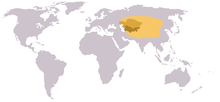Túrán

Túrán (též Turán, Turan, persky توران) je perský název[1] pro střední Asii, doslova znamená „Túrova země“. Obyvatelé Túránu byly íránské kmeny[2][3][4] avestského období. Íránská mytologie popisuje Túránce jako samostatnou větev íránského národa, sídlící v Túránu a svářící se s Íránci.[5][6]
Podle eposu Šáhnáme (z počátku 11. století, cca o patnáct století mladší než Avesta) byly kočovné kmeny osídlující střední Asii poddanými legendárního Túra, syna Ferejdúna (jehož další syn Íradž byl mytickým vládcem Íránců). Spojení Túránců s Turky vzniklo až po poturčení střední Asie, které se částečně projevilo až v této době.[7] V Šáhnáme je Túr považován za Turka,[8] přestože Túránci ze Šáhnáme a staří Turci byly zcela odlišné národy.[9]
Od počátku 20. století byl pojem Túrán používán na Západě jako všeobecné označení pro střední (či centrální) Asii. Z této doby pochází geografický termín Turanská nížina.
V 19. století a na počátku 20. století byly evropskými učenci (zejména v Německu, Maďarsku a na Slovensku) za túránské považovány národy hovořící neindoevropskými, nesemitskými a nehamitskými jazyky,[10] zejména mluvčí altajské, uralské, drávidské a japonské jazykové rodiny.[11]
Reference[editovat | editovat zdroj]
V tomto článku byl použit překlad textu z článku Turan na anglické Wikipedii.
- ↑ DONZEL, Emeri „van“. Islamic Reference Desk. [s.l.]: Brill Academic Publishers, 1994. Dostupné online. S. 461. (anglicky) Iranian term applied to region lying to the northeast of Iran and ultimately indicating very vaguely the country of the Turkic peoples..
- ↑ Edward A Allworth,Central Asia: A Historical Overview, Duke University Press, 1994. pp 86
- ↑ I. M. Diakonoff, The Paths of History, Cambridge University Press, 1999, p. 100 : Turan was one of the nomadic Iranian tribes mentioned in the Avesta. However, in Firdousi’s poem, and in the later Iranian tradition generally, the term Turan is perceived as denoting ‘lands inhabited by Turkic speaking tribes.
- ↑ According to Prof. Gherardo Gnoli:’’Iranian tribes that also keep on recurring in the Yasht, Airyas, Tuiryas, Sairimas, Sainus and Dahis’’. G. Gnoli, Zoroaster's time and homeland, Naples 1980
- ↑ E. Yarshater, Iran iii. Archivováno 16. 10. 2008 na Wayback Machine., Encyclopaedia Iranica.
- ↑ K. H. Menges, in Encyclopaedia Iranica Archivováno 17. 5. 2008 na Wayback Machine. Excerpt: "In a series of relatively minor movements, Turkic groups began to occupy territories in western Central Asia and eastern Europe which had previously been held by Iranians (i.e., Turan). The Volga Bulgars, following the Avars, proceeded to the Volga and Ukraine in the 6th-7th centuries."
- ↑ http://etext.library.adelaide.edu.au/f/firdausi/f52ek/part8.html Archivováno 13. 6. 2007 na Wayback Machine. Firdawsi, "The Epic of Kings", translated by Helen Zimmern, eBooks@Adelaide 2004]
- ↑ Edgar Burke Inlow. Shahanshah: A Study of the Monarchy of Iran, Motilal Banarsidass Pub, 1979. pg 17: "Faridun divided his vast empire between his three sons, Iraj, the youngest receiving Iran. After his murder by his brothers and the avenging Manuchihr, one would have thought the matter was ended. But, the fraternal strife went on between the descendants of Tur and Selim (Salm) and those of Iraj. The former – the Turanians – were the Turks or Tatars of Central Asia, seeking access to Iran. The descendants of Iraj were the resisting Iranians.
- ↑ http://www.medievalists.net/2009/01/04/barbarian-incursions-the-coming-of-the-turks-into-the-islamic-world/ Bosworth, C. E. "Barbarian Incursions: The Coming of the Turks into the Islamic World." In Islamic Civilization, Edited by D. S. Richards. Oxford, 1973. pg 2: "Hence as Kowalski has pointed out, a Turkologist seeking for information in the Shahnama on the primitive culture of the Turks would definitely be disappointed."
- ↑ Abel Hovelacque, The Science of Language: Linguistics, Philology, Etymology, pg 144, [1]
- ↑ Elisabeth Chevallier,François Lenormant, "A Manual of the Ancient History of the East", J. B. Lippincott & co., 1871. pg 68. [2]
Externí odkazy[editovat | editovat zdroj]
 Obrázky, zvuky či videa k tématu Túrán na Wikimedia Commons
Obrázky, zvuky či videa k tématu Túrán na Wikimedia Commons
